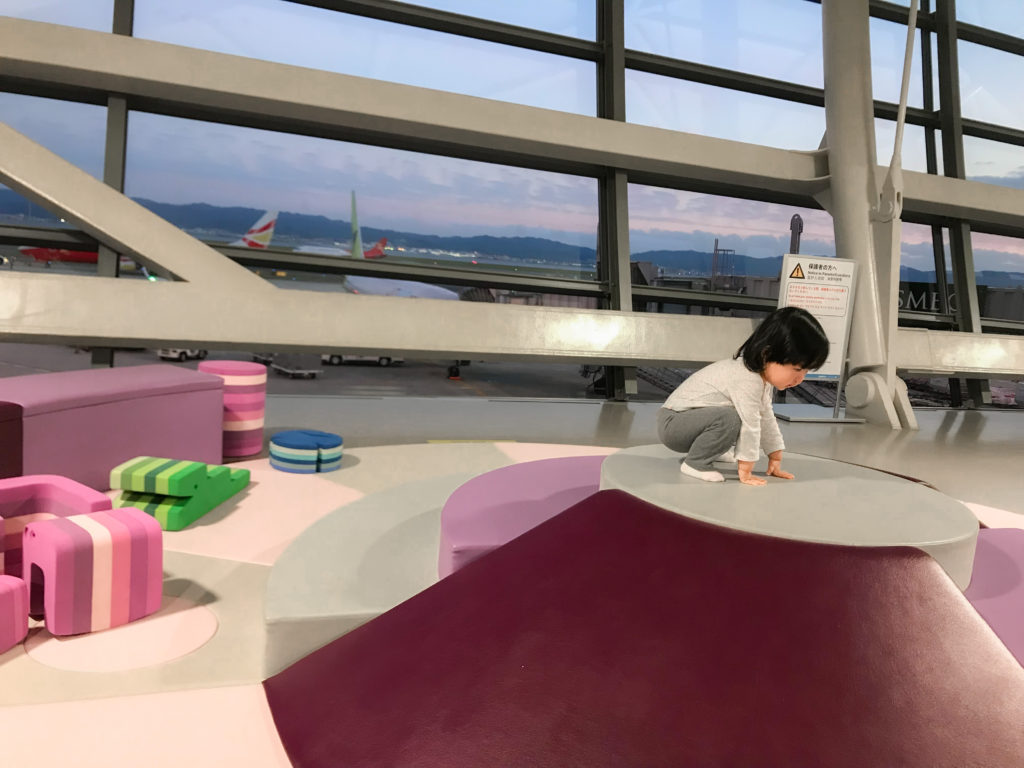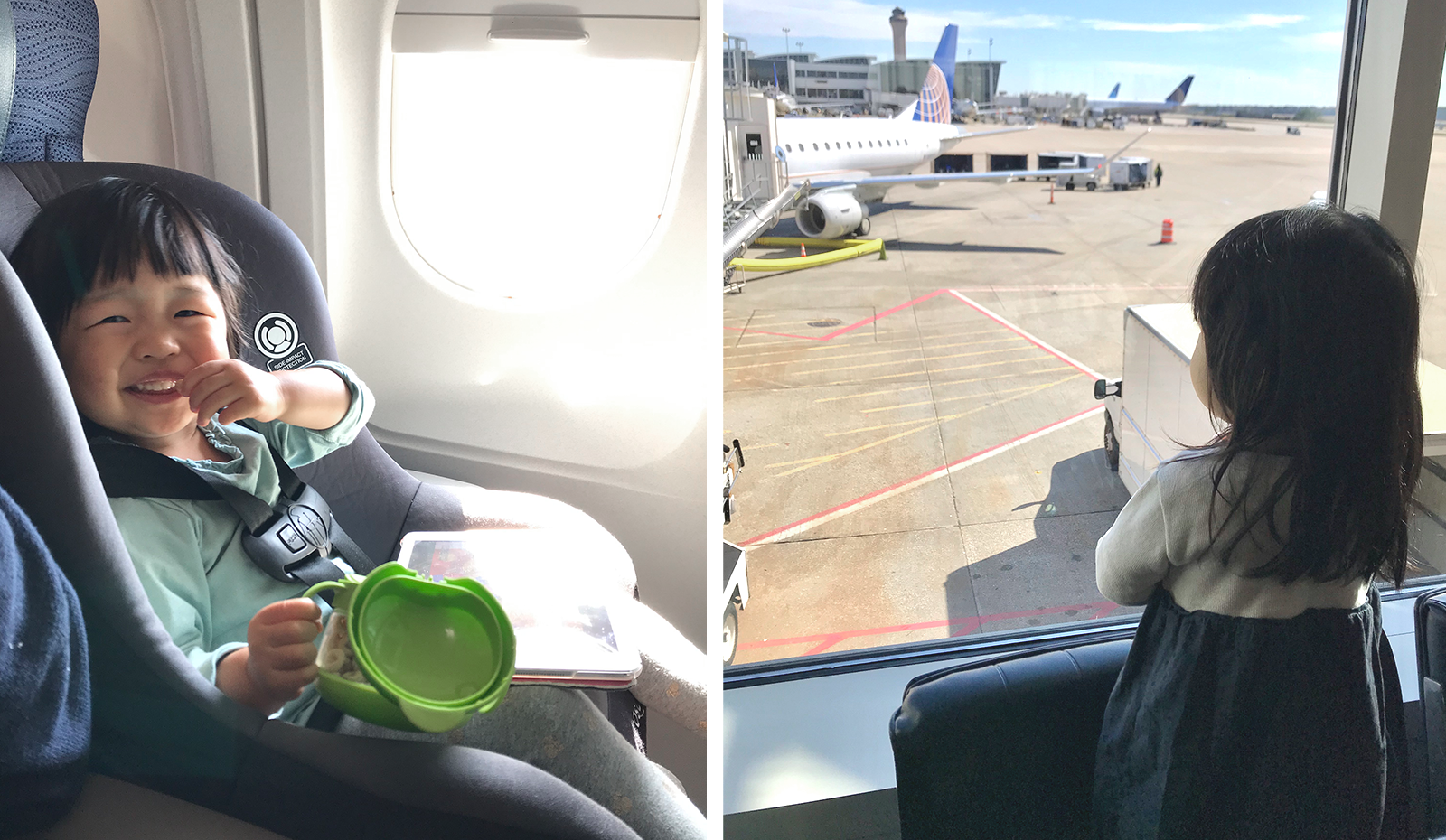My four-year-old loves to fly and wants to be a pilot when she grows up. Her eyes light up whenever we talk about traveling and she is always asking when we will be getting on a plane again.
But it wasn’t always this way.
We braved our first flight with our daughter when she was five month old— a transcontinental trip from Los Angeles to Boston for a wedding. On our return flight there was a delay on the tarmac that trapped us in the plane for an extra hour, my daughter threw up on me during the descent, and when we finally made it home with our cranky, overtired baby my husband declared, “We’re not flying with her again until she’s 10.”
…well, we actually went on to fly with our daughter a dozen more times including international long-hauls to Asia and Europe when she was a toddler, and now we are traveling with two little ones in tow. Crazy? Yes. Worth it? Also yes.
Flying with young children can be unpredictable and draining— there’s nothing quite like being confined in cramped quarters with a fussy baby or squirmy toddler that makes time feel like it’s standing dreadfully still; but, I’ve also learned that there are definitely ways to ease the stress and overwhelm and make the experience much more manageable.
Here are my favorite practical tips and strategies for easier air travel with babies and toddlers:
Talk with your little one about what to expect
For older toddlers and preschoolers, knowing what to expect at the airport and on the plane beforehand will help them feel more comfortable and excited about the experience. Talk about waiting in line, going through security, sitting in a “big” (ha!) airplane seat, and safety rules like listening and buckling the seat belt.
Reading a picture book about airplanes and airports is another great way to familiarize your child with air travel and build enthusiasm for the trip. Some of our favorites are Playtown Airport, Amazing Airplanes, and Richard Scarry’s A Day at the Airport.
Arrive at the airport early
Ticketing, checking in luggage, and security screening can all take longer with children in tow, especially if you are bringing pumped breastmilk, formula, or baby food in your carry-on. Certain liquids for babies and toddlers are exempt from the 3-1-1 liquids rule but require separate screening, which can take more time.
Start your trip off on the right foot and give yourself extra time at the airport so that you can board the plane feeling calm and collected instead of rushed and frazzled!
Bring a travel stroller and consider a travel car seat
A compact travel stroller that fits into the overhead bin and a lightweight car seat have made our travel life with kids so much easier. We absolutely LOVE our Mountain Buggy Nano stroller plus Cosco Scenera Next car seat combo; the mountain buggy nano has a universal car seat adapter system so it can transport a child AND the car seat through the airport together.
For babies and young kids, using a car seat on the plane has many advantages; it provides a safe, familiar, and sanitary place for your child one to sit (and hopefully sleep) during the flight. If you are driving when you reach your destination, you will likely need a car seat anyways so investing in a basic car seat dedicated for travel can also save you money (~$50 for the Cosco Scenera Next car seat versus ~$10 a day to rent a car seat).
Keep in mind that if your little one is flying as a lap child, you can always ask during ticketing and at the gate whether there are any extra seats available so you can use your car seat on board. Barring a full flight, most airlines are fairly accommodating about giving free seats to a lap child. If this doesn’t work out though, don’t worry— checking in your car seat is free on all major U.S. airlines, just have a protective car seat bag ready.
Should you fly during nap time or take a red-eye? It depends
I think we can all agree that a child sleeping through the flight is the absolute best case scenario, especially for longer journeys. For babies under 6 months and not yet mobile, flying around nap time is a good bet since the white noise from the jet engines, dim cabin lighting, and even some mild turbulence does a pretty good job at lulling baby to sleep; but, for more active toddlers who fight sleep, this strategy could potentially backfire.
Ultimately, choosing the “ideal” flight time will depend on your child’s sleep habits, temperament, and your own anxiety level. Consider whether your child usually falls asleep in the car, regularly sleeps through the night, or goes down for naps fairly easily. Also, think about your own energy level and motivation to do an overnight flight; if you are intensely dreading the flight yourself, then it’s probably not a good idea to begin with.
Sometimes the only way to really know is just to try. On a trip to Europe, we took a red-eye on the way there and a daytime flight on the way back. The red-eye was exhausting for sure, but my daughter slept for most of that flight; on the other hand, entertaining her for 11 hours (out of which she only slept for 30 minutes) during the daytime return flight made me want to pull my hair out. So, now we know.
Organize your carry-on essentials with separate ziploc bags
Avoid the annoyance of having to constantly dig around in your bag during the flight by organizing your essentials into separate gallon ziploc bags according to how you will use them. For example, have all of the diapering necessities in a single bag that you can just grab and take to the bathroom. If you are bringing formula, milk, or baby food, those should already be grouped together in a ziploc for security screening. Have another bag for all the snacks and another one for all the toys.
Also, if you are flying with an older toddler or preschooler, pack them a little backpack with their own most-reached-for items (water bottle, snacks, toys, jacket); this is especially helpful if you are traveling with multiple children to prevent the mental fatigue of having to keep track of everyone’s stuff.
Prepare to be hands-free as much as possible at the airport
Navigating the airport with babies and toddlers is so much easier when your hands are free. Plan to carry as little as possible in your arms by baby wearing, checking in most of your luggage, using a backpack for your carry-ons, and pushing a stroller.
Before the flight: walk, water, and diaper change
Your little one is about to be staying put (fingers crossed) for the next few hours or more so let them walk around and get out as much energy as possible after passing through security. Take advantage of any extra time before boarding to fill up those water bottles and make sure your baby or toddler starts off the journey with a clean diaper!
The walking also goes for once we get off long international flights. Whenever possible, I try to walk my toddler from the plane all the way to baggage claim after international flights because after collecting our check-ins, we still have to pass through immigration control and that’s when little ones need to be strapped back into a stroller or carrier. If they are able to get out their energy before that time comes, waiting in a potentially long line will be much more manageable.

Divide and conquer during boarding
It has worked really well for our family to stagger boarding and split up the responsibilities. My husband is in charge of all the gear (folding up the stroller, anything that needs to be checked at the gate, installing the car seat on the plane, and sanitizing the seat area) and he boards first; I handle the kids and usually by the time we get to our seats, my husband will already have everything mostly set-up and cleaned so we can just focus on getting the children settled.
Once you are on the plane, set up your essentials within reach
There’s nothing more annoying than having to contort yourself in the already narrow seat space to reach for a bag stowed underneath the seat every time you need a snack, wipe, or bottle. So, when you settle into your seat, make sure you have a few essentials within arms reach.
Make use of the seat front pocket to tuck away a bottle and a pack of wipes and put a ziploc of pacifiers, hand sanitizer, or a small pack of snacks in your jacket pocket to save yourself some hassle (and from pulling a muscle).
Feed during takeoff and landing
Sucking and chewing helps little ones to avoid ear pain caused by the change in air pressure so be prepared to give a bottle, nurse, or offer a pacifier during takeoff and landing. For a toddler, a water bottle, snack, or applesauce pouch works great too!
For some reason I tend to forget about this during the descent (maybe it’s all the excitement of we’re almost there!) and since your child is likely already worn down from the flight, any discomfort will probably be much more distressing during the last 30 minutes of a flight than the beginning. So, just remember to have snacks or a bottle saved for the landing too!
Snacks, activities, screens, and repeat! But also remember rest
The three things that make a flight with kids go downhill fast are hunger, fatigue, and boredom. We combat these three pitfalls by preparing our own arsenal of three: snacks, activities and screens.
For snacks, bring a lot (domestic flights are pretty lacking in good food options for kids) and minimize sugary treats. Some great options are popcorn, pita chips, fresh fruit, raisins, dried fruits, goldfish, cheese sticks, and cheerios.
For toys and activities, I prefer things that are compact and flat like a mini etch-a-sketch, LOTS of stickers, pop-its, crayons, water wow books, and post-it notes. For a baby, almost anything in your purse or on the plane can be turned into a distraction— empty wrappers, keys, empty cups, a napkin— so you can keep it simple!
Now for the real MVP of keeping kids entertained: screens. We pre-load our ipad with games, shows, and movies, and a comfortable pair of child-sized headphones is a must!
Between the snacks, toys, and screens, don’t forget that the best thing for a little kid’s behavior and mood is rest. Watch for sleep cues and try to wind down the activities before your child is overstimulated or overtired. We usually encourage rest right after a substantial snack or meal, using food coma to our advantage. Try switching to calm music or white noise on the headphones, put a blanket over them, or even pretend to sleep yourself to encourage your child to get some shut-eye.
Save walking the aisles as a last resort
We try to treat the flight like a long car ride— we don’t get out of our seats unless it’s to go to the bathroom.
Often, walking the aisles is not an option anyways because of turbulence, food and beverage service, or other passengers needing to pass through. It can also be particularly hard to reign a toddler back in after they catch wind that there is somewhere for them to walk around and explore.
Most importantly, a calm mindset and patience makes all the difference!
So many things are out of your control when flying with little ones— how your children will behave, flight delays, long lines, and the reaction of passengers around you; ultimately, the one thing that you can control is your own mindset and attitude.
For better or for worse, you set the tone. Sometimes, despite your best efforts, things will still go awry. In those moments, staying calm and taking deep breaths go a really long way, and often your demeanor will rub off on your children.
I’ve gotten the side-eye and passive-aggressive comments, but I’ve also received plenty of kindness and encouragement from strangers too. So, just do your best to prepare your children, your stuff, AND yourself.
With a little luck and a prayer, hopefully the next time you get on a plane with your little one, the time will just fly by.



Leave a Reply